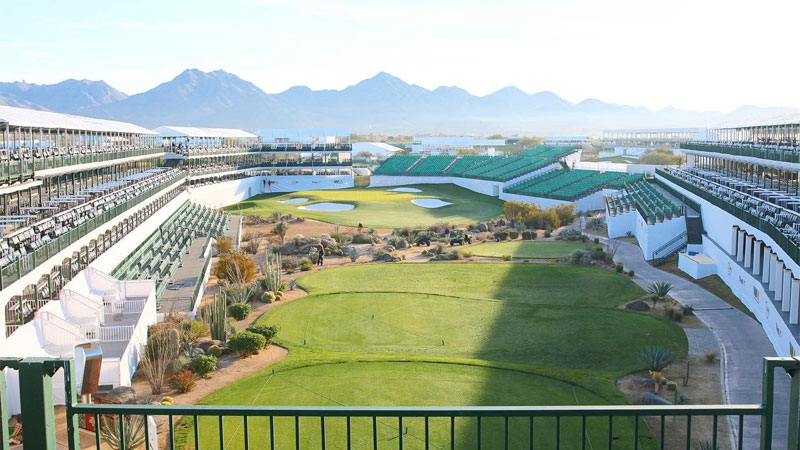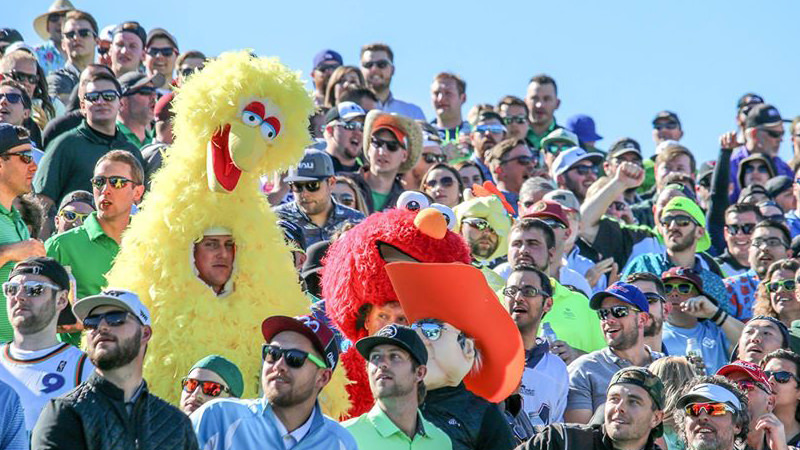On Feb. 6, 2016, Ryan Palmer lined up his putt on the 10th hole at TPC Scottsdale, the annual venue of Arizona’s Phoenix Open. He pulled back his club, ready to caress the ball into the hole, when a nearby spectator cried out “miss it!” just as Palmer was mid-stroke. The player stopped, composed himself, and once again readied his stroke. Again, the heckling voice shouted out, “miss it!”
After a third call came out, James Edmonson, Palmer’s caddy of 18 years, jumped into action. “I walked all the way around the green and went right up to the rope [separating the crowd from the course]. I pointed at him and I was like, ‘Hey, come here!’” Edmonson says, describing the heckler as a “frat punk” wearing a “stupid little tie.”
“I was going to pull his tie and pull him over the rope,” he recalls. “‘Cause once you get inside the ropes, you know, it’s fair game.” The fan backed down — “like a keyboard warrior on social media” — but when the next group of players arrived on the green, his antics resumed. Security staff soon decided enough was enough and kicked him out. “I’ve never seen anything like it before,” Edmonson says.
Professional caddies’ typical duties include carrying golf bags, calculating shot lengths, and determining which club their player should use to make a shot. Altercations with “frat boys” is not, as the old adage goes, par for the course. But the Phoenix Open is an event like no other on the PGA Tour.
Officially billed as the Waste Management Phoenix Open, the tournament is better known among golf fans as the “Greatest Show on Grass.” The event eschews the sport’s rigid etiquette, with raucous crowds, a festival-like atmosphere, and extra-curricular activities that extend well into the night. Its annual attendance figures closer resemble music festivals than sporting events.
The tournament is notorious for its spectators’ epic alcohol consumption. In a bid to curb overindulgence and crackdown on DUIs, the Scottsdale Police Department introduced free breathalyzer tests as part of a “Know Your Limit” campaign in 2012. Meanwhile, the event’s costly corporate boxes, which are sold with “open” bars, set a 10-drink limit per person a few years back. Even with that in place, multiple sources told VinePair that bartenders are happy to ignore the limit when tipped generously.
“The way I try to explain the Phoenix Open to people that have never gone is, ‘Imagine a humongous bar or outdoor party, and in the middle of it, there’s a golf tournament going on,’” Edmonson says. “I mean, 90 percent of the people attending don’t really care about the golf.”
His estimate, though unscientific, is telling. The seven-day event takes place during Super Bowl week and concludes the first Sunday of February. The competition itself spans Thursday through Super Bowl Sunday; but practice rounds on Monday and Tuesday, and Wednesday’s celebrity Pro-Am, which has previously featured the likes of Mark Walhberg, Michael Phelps, and Aaron Rogers, draw crowds of up to 70,000.
In terms of attendance, there’s only one winner between the Super Bowl and the Phoenix Open. The highest-attended Super Bowl in history barely breached 100,000 spectators. In 2018, more than 200,000 fans turned out at the Phoenix Open on Saturday alone. Over the seven-day period, close to 720,000 people crossed its gates.
The Phoenix Open’s attendances don’t just trounce almost every event on America’s sporting calendar, they make Burning Man, which receives some 70,000 visitors annually, seem like a county fair by comparison. Only Coachella, the celebrity-stacked music festival that takes place over six days on two separate weekends, boasts similar numbers.
The jewel in the tournament’s crown is the legendary par-3 16th hole, hailed as the “most electrifying” in all of golf. It holds a singular place within the sport, owing to the 20,000-capacity grandstand that completely surrounds the hole. On competition days, thousands of spectators queue from as early as midnight the night before gates open to try to claim a spot in the stands.

When play begins, the raucous crowd is ruthless. Players enter the golfing coliseum through a makeshift tunnel before stepping up to the infamous tee. Find the green with their shot, and the stadium celebrates with rapturous fervor; miss it, and the 20,000-strong crowd erupts with catcalls and jeers.
Players “can embrace it and play along with it,” Edmonson says. “But if you try to fight it, they’ll crucify you.”
Tiger Woods embraced it. In 1997, with a 9-iron in his hand, as he reached the top of his backstroke, the TV caller said: “They’re going to go nuts when he hits this thing.” Less than a second later, Woods’ ball took off from the tee box, and the noise from the crowd reached the level of a Boeing 747 during takeoff.
When the ball finally hit the green, it bounced twice and dropped into the hole. The crowd practically broke the sound barrier in celebration. After high-fiving his caddy and playing partner, Woods turned to the crowd and alternated between fist pumps and “raise the roof” motions for the entirety of the 152-yard walk to collect his ball from the hole.
Some of the players even encourage the crowd to cheer and make noise while they’re hitting their shot. “No other hole in golf really has that,” says Ryan Conlogue, an insurance group service operations supervisor who attends the Phoenix Open every year.

Like many spectators, Conlogue turns up to the event in fancy dress. Cast a gaze across the stands that line 16, and you’ll see gorilla suits, caddy overalls, Sesame Street characters, and Where’s Waldo (if you can spot him).
Conlogue arrives dressed as professional golfer Rickie Fowler, a one-time winner and two-time runner up at the tournament, with whom he bears a striking resemblance. “People do some wild things out there, so it’s just what I do to kind of be funny,” he says.
Like Edmonson, Conlogue estimates that most people in the crowd are not there for the golf — nor to enjoy just one or two drinks. “People are there to drink all day,” he says.
When play eventually stops, the party continues at the Coors Light Birds Nest, a 50,000-square-foot live music venue and the official afterparty that takes place every night from Wednesday through Saturday. Its headline acts span musical genres from country to punk rock to hip-hop.
On Feb. 1, 2019, Snoop Dogg took the Birds Nest’s party atmosphere to “a whole new level,” according to local news site AZCentral, when he brought pole dancers, “blunts,” and worked the crowd with iconic hits like “Gin and Juice” and “Drop It Like It’s Hot.”
“It’s just a really cool atmosphere — people hanging out, enjoying music, and enjoying some beverages,” Conlogue says.

Among all the partying, some still find time to use the event for their business interests. Patrick Shaughnessy, a 67-year-old finance industry veteran, has attended the event for more than 20 years. Through his work, he gains access to one of the corporate “Skyboxes” that overlook the 16th hole.
For $53,000, the corporate package includes 34 Skybox tickets per day, and perks such as complimentary food (breakfast, lunch, and an afternoon buffet) and an “open” bar. While general admission costs between $45 and $60 depending on the day, Shaughnessy says the $1,500 per person for the Skybox is a canny investment and describes it as the “best business development tool ever.”
The tournament offers similar, slightly cheaper packages on the 17th and 18th holes, but it’s 16 that holds the biggest pull. “My clients always wanted to go, so I had to take care of them,” Shaughnessy says. “And then they’ve wanted to bring their friends — prospects in my world. So I’ve gotten many, many introductions to people from all over the country who come here for this thing.”
Shaughnessy calls the 16th hole “the madhouse,” and says Friday and Saturday at the event are “just insanity.” But when there’s potential business to be done, just like the golfers, “you have to be on your game,” he says. “I have a tendency to pace myself out there because I know it’s a marathon, not a sprint.”
Perhaps the most subtle of the tournament’s quirks is its title sponsor, Waste Management. In place of the requisite insurance companies, investment banks, cell phone networks, or luxury carmakers that tend to align themselves with elite sporting events, the Phoenix Open has been supported by a company that specializes in trash disposal and recycling for the last decade.
In a way, it comes full circle. “When you put 160 to 170,000 people on a property, and you have to open up the next day and play golf, that property looks like the remains at Woodstock,” Shaughnessy says. “The place is a mess.”
While spectators get wasted, Waste Management cleans up the mess. Shaughnessy believes it’s a perfect fit. “I’m telling you,” he says, “they couldn’t have found a better sponsor.”